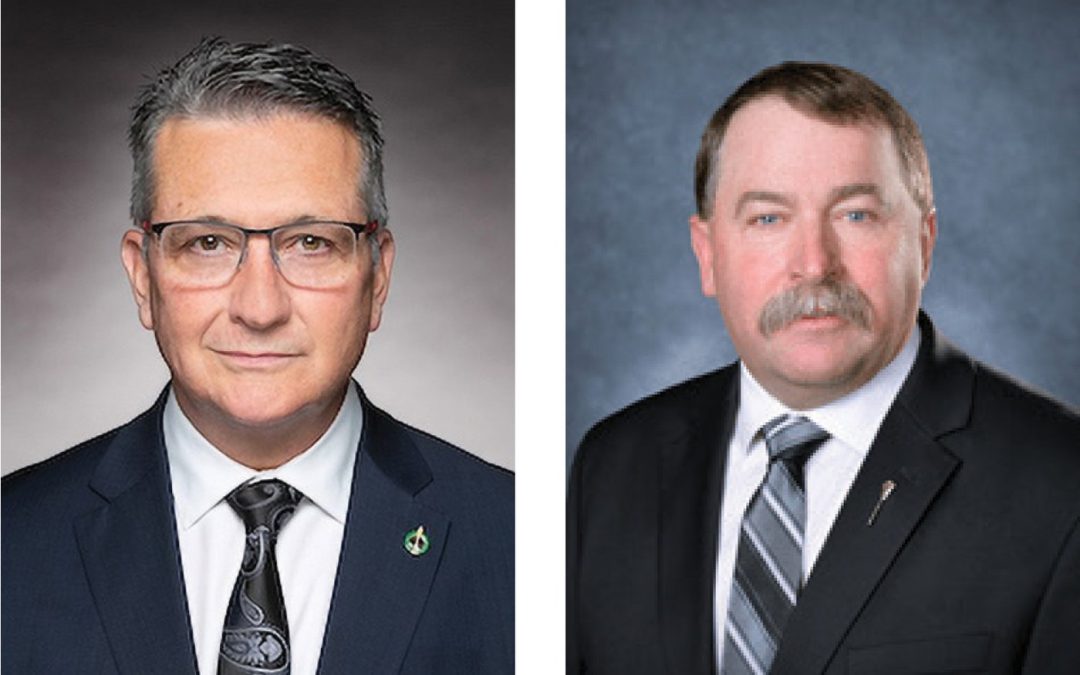Photo: Federal Agriculture Minister Heath MacDonald, left, and Saskatchewan Agriculture Minister Daryl Harrison, right / Ryan Kiedrowski, Local Journalism Initiative Reporter
By Ryan Kiedrowski
Local Journalism Initiative Reporter
The World-Spectator
In a year plagued with drought conditions and trade instability, both federal and provincial levels of government announced a boost to the AgriStability program last week.
“It’s nice to be able to announce those today,” said provincial Agriculture Minister, Daryl Harrison on July 21. “I think producers are looking forward to it, producer groups are looking forward to it. It’s nice to see it come to fruition.”
AgriStability helps farming operations that face a large margin decline caused by production loss, increased costs, or market conditions. Personalized for every producer who enrols, coverage uses historical information based on income tax and supplementary information. Delivered through the Saskatchewan Crop Insurance Corporation, it’s one of the business risk management programs in the federal Sustainable Canadian Agricultural Partnership. For this year only, participants in the AgriStability program will see an increase in the compensation rate from 80 to 90 per cent and the maximum cap is doubling to $6 million per operation.
Some parts of Saskatchewan are experiencing the “worst drought in a decade,” with 44 per cent of the province listed as under drought conditions and 38 per cent classified as abnormally dry. The severity in some places is reminiscent of the Dirty Thirties—leading to the RMs of Enterprise, Maple Creek, Fox Valley, Waverley, Big Stick, and Wood River declaring a local state of emergency.
“Now is the time for unity, and we are working together to deliver for producers right across the country to make sure our programs work for them,” Heath MacDonald, federal Minister of Agriculture and Agri-Food said. “That is why, at our meeting last week, we agreed to make changes to AgriStability so that producers facing trade uncertainty and dry conditions have more protection.”
As for future changes, AgriStability will see adjustments to the feed inventory pricing for livestock, starting in 2026. Some allowable expenses are also under consideration for the 2026 program year.
“The Saskatchewan Cattle Association has long advocated for changes to the eligible feed expenses and changes to the feed inventory pricing for AgriStability,” SCA Chair Chad Ross said. “We applaud the changes announced today, including moving forward with the permanent change to the feed inventory pricing for the 2026 program year. This should make the program more responsive for livestock producers. We will continue to advocate for the allowable feed expenses to become permanent as well.”
From the years 2018 to 2023, the AgriStability program paid out more than $645 million in benefits, and payments are trending higher for the 2024 program year. The deadline for producers to enrol in the 2025 AgriStability is fast approaching, even though it has been extended to July 31 (from April 30).
Chinese tariffs continue to worry canola producers
During the virtual meeting between MacDonald and provincial and territorial ag ministers, the Chinese canola tariff was another hot topic. Put in place back in March, China imposed a 100 per cent tariff on Canadian canola oil and meal, which was in response to Canada’s tariff on Chinese electric vehicles, steel, and aluminum.
“Our trade is a moving target,” Harrison told the World-Spectator. “My biggest question from producers is China, and the canola oil and canola meal specifically— peas as well. They’re worried about the trade with China, because China’s tariffs are counter tariffs in response to our federal government’s 100 per cent EV tariffs.”
Harrison says there appears to be no movement with regards to the Chinese canola tariff
“I brought it up at the FPT call, but also directly to Minister McDonald,” Harrison explained. “He said there are talks going on, that they are engaged. I said, ‘that’s the first question that’s most often asked,’ and the fact there’s been little or no mention to it in any of the federal government’s dialogue, nor in any media. Not knowing anything is probably worse than getting bad news, but most certainly, everybody’s kind of waiting on pins and needles just to see. It’s a huge cash crop for our producers, and then our canola crushers are also right in the middle of this.”
Harrison also continues to be boggled as to the reasoning behind the retaliatory tariffs from China, citing the Chinese EV market in Canada doesn’t seem to be all too large.
“We’ve been pushing the federal government since the counter tariffs came in, and actually even prior to it, because we knew when they initiated the tariffs on EV vehicles, that there could be repercussions, and there eventually was,” he said. “We still continue to pressure the federal government—the new prime minister and new federal ag minister—they need to engage with China on a nation to nation level and get this resolved.
“I’m not sure that there’s even an electric vehicle market here in Canada to try to protect, so it’s really unclear as to what the intention was of our federal government to impose this in the first place,” Harrison concluded.
